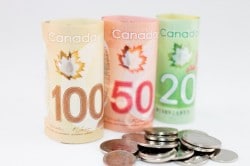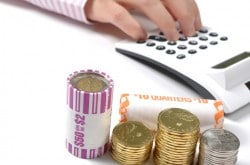Paying for Things in Niagara Falls
November 23, 2014 4:15 pm The United States and Canada are so close — both in location and culture — that it can be easy to forget they are completely different countries. However, Canada has its own government, its own laws, and, most crucially for travelers, its own system of currency.
The United States and Canada are so close — both in location and culture — that it can be easy to forget they are completely different countries. However, Canada has its own government, its own laws, and, most crucially for travelers, its own system of currency.
Most Americans are familiar with Canadian currency only from the slightly different coins that make their way into our pockets and handbags. However, because the system is separate, you’ll need to convert your good U.S. dollars into Canadian ones — and to do that, you’ll need to know a bit about Canada’s currency.
Understanding Canadian Money
Canadian currency is based around the Canadian dollar, also denoted by C$ or CAD. In recent years, the Canadian dollar has been about on par with the U.S. dollar, so trying to fit Canadian prices into your U.S. budget shouldn’t be too difficult.
Just like American money, Canadians use bills in denominations of $5, $10, $20, $50, and $100; however, while Americans still use $1 bills (and $2 bills to a lesser degree) long ago Canadians replaced these small denominations with coins. Real Canadians call these coins loonies (for $1) and toonies (for $2) because the traditional $1 coin had a picture of a familiar Canadian bird called a loon. Along with these funny coins, Americans probably know that Canadians use their own quarters, dimes, nickels, and pennies — though the Canadian government recently chose to stop producing the penny due to the excessive cost and little benefit.
The paper bills are becoming more and more brightly colored to make counterfeiting easier to spot — just like American dollars. Each bill is a different hue, to make spotting different denominations easier. Also to dissuade counterfeiters, the Canadian government has stopped producing paper money, choosing instead to print bills on polymers.
Using Canadian Money
 Because Niagara Falls crosses the border and exists in both America and Canada, most attractions and retailers even on the Canadian side will accept U.S. dollars as well as American credit and debit cards. So planning a trip to Niagara Falls is really quite simple for American tourists. However, the exchange rate that many retailers provide may not be accurate to the actual national rate, so it is difficult to predict expenditures when you show up with only American cash in hand. Additionally, if you want to venture farther into Canada, perhaps to Niagara-on-the-Lake or even Toronto, it is wise to exchange your American cash for the Canadian counterpart.
Because Niagara Falls crosses the border and exists in both America and Canada, most attractions and retailers even on the Canadian side will accept U.S. dollars as well as American credit and debit cards. So planning a trip to Niagara Falls is really quite simple for American tourists. However, the exchange rate that many retailers provide may not be accurate to the actual national rate, so it is difficult to predict expenditures when you show up with only American cash in hand. Additionally, if you want to venture farther into Canada, perhaps to Niagara-on-the-Lake or even Toronto, it is wise to exchange your American cash for the Canadian counterpart.
U.S. citizens have a variety of options for obtaining Canadian currency. The most popular method is to utilize exchange kiosks found in popular tourist areas, including airports and border crossings. These kiosks will tell you what the current exchange rate is and either replace your current U.S. bills with Canadian ones or else pull money out of your debit account and provide you with fresh Canadian dollars. However, you can also visit banks and even ATMs to withdraw Canadian money, though these sources will certainly charge you one or more usage fees.
Once you’ve procured your Canadian denominations, you can go wild on your great white vacation. You can even save a loony or a toony as a souvenir — just don’t try to spend them when you’re back in the states.
Categories: Falls Avenue Resort
